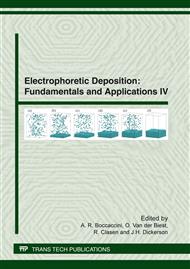[1]
M.W. Barsoum and T. El- Raghy, Synthesis and Characterization of a remarkable ceramic: Ti3SiC2, J. Am. Ceram. Soc. 79 (1996) 1953-(1956).
DOI: 10.1111/j.1151-2916.1996.tb08018.x
Google Scholar
[2]
K. Tang, C.A. Wang, Y. Huang, J. Xia, An X-Ray diffraction study of the texture of Ti3SiC2 fabricated by hot pressing, J. Eur. Ceram. Soc. 21 (2001) 617- 620.
DOI: 10.1016/s0955-2219(00)00246-6
Google Scholar
[3]
A. Murugaiah, A. Souchet, T. El-Raghy, M. Radovic, M. Sundberg, and M. W. Barsoum, TapeCasting, Pressureless Sintering, and Grain Growth in Ti3SiC2 Compacts J. Am. Ceram. Soc. 87 (2004) 550-556.
DOI: 10.1111/j.1551-2916.2004.00550.x
Google Scholar
[4]
C. Hu, Y. Sakka, S. Grasso, T. Suzuki and H. Tanaka, Tailoring Ti3SiC2 Ceramic via a Strong Magnetic Field Alignment (SMFA) Method Followed by Spark Plasma Sintering (SPS), J. Am. Ceram. Soc. 94.
DOI: 10.1111/j.1551-2916.2010.04186.x
Google Scholar
[3]
(2011)742–748.
Google Scholar
[5]
C. Hu, Y. Sakka, T. Nishimura, S. Guo, S. Grasso and H. Tanaka, Physical and mechanical properties of highly textured polycrystalline Nb4AlC3 ceramic, Sci. Technol. Adv. Mater. 12 (2011) 044603 (6pp).
DOI: 10.1088/1468-6996/12/4/044603
Google Scholar
[6]
L. Besra, M. Liu, A review on fundamentals and applications of Electrophoretic deposition (EPD), Prog. Mater. Sci. 52, (2007) 1-61.
Google Scholar
[7]
M. Mishra , S. Bhattacharjee, L. Besra , H.S. Sharma, T. Uchikoshi, Y. Sakka, Effect of pH localization on microstructure evolution of deposits during aqueous electrophoretic deposition (EPD), J. Eur. Ceram. Soc. 30.
DOI: 10.1016/j.jeurceramsoc.2010.04.034
Google Scholar
[12]
(2010) 2467-2473.
Google Scholar
[8]
Y. Liang, Z. Sun, J. Chen, X. Liu, Y. Zhou, Electrophoretic Deposition of Ti3Si(Al)C2 from Aqueous Suspension, J. Am. Ceram. Soc. 93.
Google Scholar
[7]
(2010)1916–(1921).
Google Scholar
[9]
Y. Sakka, T.S. Suzuki, T. Uchikoshi, Fabrication and some properties of textured alumina-related compounds by colloidal processing in high-magnetic field and sintering, J. Eur. Ceram. Soc. 28 (2008) 935–942.
DOI: 10.1016/j.jeurceramsoc.2007.09.039
Google Scholar
[10]
Y. Sakka, T. S. Suzuki, Textured development of feeble magnetic ceramics by colloidal processing under high magnetic field, J. Ceram. Soc. Jpn. 113.
DOI: 10.2109/jcersj.113.26
Google Scholar
[1]
(2005) 26-36.
Google Scholar
[11]
Bimal P. Singh, Ruben Menchavez, Chika Takai, Masayoshi Fuji, Minoru Takahashi, Stability of dispersions of colloidal alumina particles in aqueous suspensions, J. Colloid Interface Sci. 291 (2005) 181–186.
DOI: 10.1016/j.jcis.2005.04.091
Google Scholar


